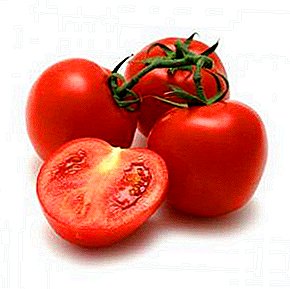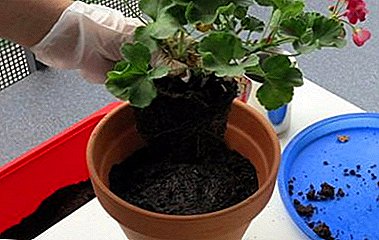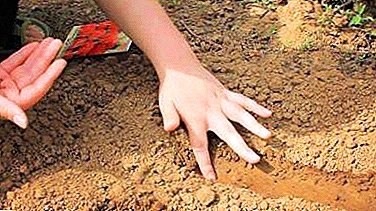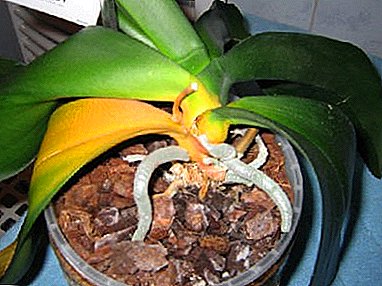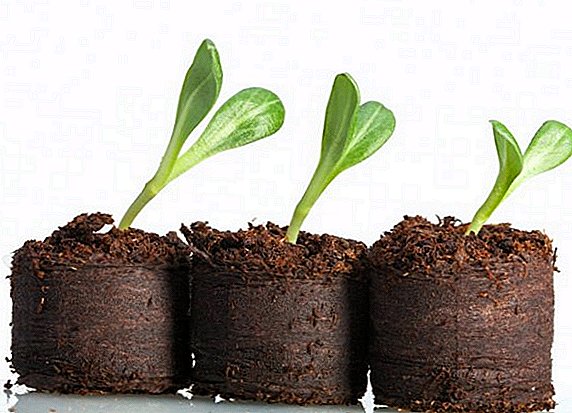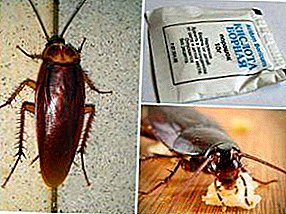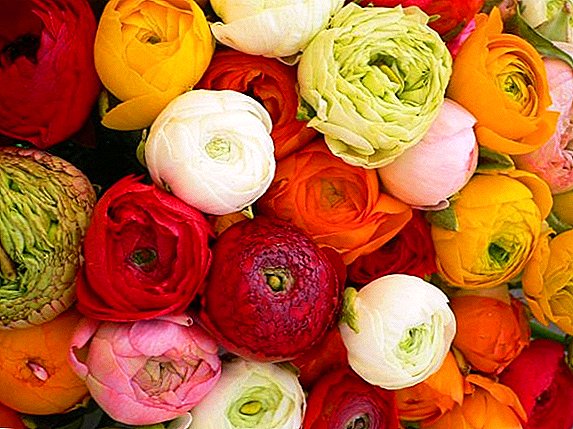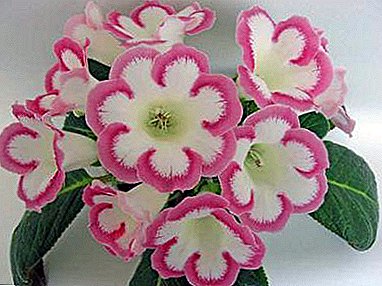
Rosalind gloxinia belongs to unpretentious and abundantly flowering varieties. This hybrid flower is widely used in home floriculture. This type of gloxinia is quite unpretentious in care, so even novice growers can cope with its breeding. But certain nuances of cultivation still exist. In this article, you will learn how to choose the right substrate and place for planting Rosalind gloxinia bulbs, how to properly care for it, what time the plant needs to be fertilized with fertilizers and how to help it overwinter. Also tell you what the most common diseases can hit this incredibly beautiful flower.
Botanical description and history
Rosalind gloxinia belongs to a large family of Gesneria. Perennial shrub comes from Brazil. It was discovered in the 18th century by the German botanist Gloxin, whose name is given to this flower.
Rosalind variety - hybrid, refers to the standard types of gloxinia. Tuberous flower. Root scaly structure. Stems straight. The leaves are located opposite. Stems and leaves are bare, some suborts may be covered with small fibers.
Flowers solitary, grow from the axils of the leaves. The shape of the flower bell. It has one row of petals on a white corolla. Seeds are small, ripen in large quantities.
Description of appearance and features
Rosalind's gloxinia grows in a diameter of more than 25 cm. The flowers are snow-white, having bright crimson border of petals. The heart of the flower is gently yellow. Peduncles of medium length, strong, light green shade.
The leaves are saturated green, grow densely. The shape of the leaves is elongated, pointed at the ends, grow to a length of 15 cm. The variety has abundant and fairly long flowering.. After timely pruning may re-bloom.
When re-flowering border may disappear, the flower becomes pure white. The flowers themselves have a delicate delicate aroma. The grade is unpretentious, even beginners can be engaged in its cultivation.
A photo
In the photo you can see the beauty of Rosalind gloxinia.



Landing: instructions, rules and tips
The main thing is to prepare the tubers for planting. They can be stored at a temperature of 12 - 15 ° C for 4 months, until the end of February, peppered with sawdust or sand. Before planting in February, the tubers are rearranged to a warm place, they begin to moderately moisturize.
Tuber planting scheme:
- Planted tubers, which sprouted sprouts.
- A large tuber is divided into parts, in each of which there should be a 1-2 sprout.
- Tubers are treated with a solution of manganese.
- A drainage layer is laid in the pot.
- Poured on top of a special substrate.
- Tuber deepened by 1 cm.
The top of the tuber when planting is not deepened, it complicates the germination of shoots.
Transplant is performed annually. When transplanting the pot must be used a little larger than the previous one, up to 10 - 15 cm in diameter.
Lighting and location
Gloxinia Rosalind very light-requiringBut it’s better to shade the southern windows from direct sunlight with a light curtain. Light should be bright but diffused. Do not place pots near air conditioners or in a draft; a flower does not tolerate cold air flows.
From the direct sun leaves get burned - brown spots.
On the north side of the house, cultivation is permissible, but then the temperature of the content should be raised to 18 - 20 ° С The optimal location of the pots - southeast windows. In winter, for the extension of daylight, additional lighting is required with special lamps for 3-4 hours per day. Light day should be at least 12 hours.
If the leaves and stems are pulled up, the flower lacks light.
Soil requirements
The substrate is better to buy in the store, suitable soil mix for violets or begonias. You can prepare the substrate yourself.
 The composition of the soil mixture for Rosalind gloxinia:
The composition of the soil mixture for Rosalind gloxinia:
- Leafy ground - 2 hours
- Humus - 1 hour
- Sand - 1 hour
- Drainage layer.
Peat mixture can be used:
- Leafy ground - 3 hours
- Peat - 1 hour
- Sand - 1 hour
- Drainage of expanded clay, rubble.
How to care?
- Temperature. Gloxinia Rosalind is a thermophilic flower. Before flowering and after the optimum air temperature - up to 20 ° C. During the rest period, the flower needs a cool content - 12 - 15 ° С.
From hypothermia leaves droop, look lifeless.
For long flowering pots set on a warm shelf or set on special racks.
- Top dressing. Fertilizing the substrate is desirable after flowering with mineral fertilizers containing potassium, phosphorus, for example, monophosphate. During the period of active growth, nitrogen fertilization is required to build up green mass. Fertilizers are applied 1 time per 10 - 13 days through watering. You can feed the flower with organic fertilizer - well diluted mullein. Also use complex dressings for flowering plants. Florists recommend alternating fertilizers. From the end of summer, the feeding is suspended, the flower is being prepared for rest.
From a lack of nutrients the leaves become shallow, flowering slows down. Excess fertilizer is also dangerous to the flower. It is necessary to strictly follow the instructions, not violating the proportions and timing of dressings.
- Watering. Rosalind gloxinia requires moderate watering. During the period of growth, it is better to water the flower in the pan, for example, the upper watering in small doses.
When watering water should not fall on the flowers and leaves, should be watered at the root. Water used for irrigation only clean, separated by at least 2 days, warm.
In the summer heat the flower requires additional humidification. Next to the pots should be installed additional containers of water. You can set the pots on trays with wet clay.
 Pruning. After flowering, cut off all the stems and leaves, leaving 2 - 3 lower leaves. This procedure contributes to the growth of new stems and re-bloom.
Pruning. After flowering, cut off all the stems and leaves, leaving 2 - 3 lower leaves. This procedure contributes to the growth of new stems and re-bloom.During this period, the flower should be fed with growth hormones.
The second bloom usually occurs after 3 to 4 weeks. The second time flowering is not so lush, but lasts almost all summer. In September - October, dried stems and leaves must be cut for wintering tubers.
When pruning over a tuber, it is necessary to leave a stump with a height of no more than 1 - 2 cm.
- Wintering care. Tubers are stored in a dark cool room until the end of winter. In order for the tubers not to dry, light moistening is required, 1 - 2 times a month.You can store tubers in the lower part of the refrigerator. You should first put them in a bag with a mixture of substrate and vermiculite. Moisturizing is not required.
Common diseases and pests
Gloxinia Rosalind often suffers from excessive moisture, high humidity, lack of light and heat.
- Gray rot and other fungal infections. Symptoms of the disease: the stems turn black, thin, brown spots appear on the leaves. Requires sanitary cleaning of the bush, all affected leaves and stems must be cut. It will help the treatment of the bush and substrate fungicide or other insecticides.
- Root rot. It arises from overflow. The stems begin to rot, the roots darken, the flower faces death. It requires urgent transplantation to a new substrate, treatment with insecticides and temporary quarantine.
- Fungal diseases - powdery mildew, late blight spreads to healthy flowers. For prevention, it is necessary to repeat the treatment of the soil and leaves after 2 weeks with phytosporin or foundation.
- Thrips, spider mite. Signs of viral lesions: the leaves shrink, the underside of the leaf is covered with bloom from accumulated insects. The edges of the leaves are wrapped inside, the stem begins to curl.
Spider mite leaves white dots on the leaves, turning later on in yellow spots. A thin web enclosing the stems and leaves appears.
Thrips leave silver streaks and stripes on the leaves. The larvae enter the substrate. In this case, only partial or full replacement of the soil and flower transplant will help.
From all viral adversity requires careful processing of leaves, stems, substrate aktar, fitovermom. The procedure should be repeated at least 3-4 times every 7-10 days.
Breeding
Rosalind gloxinia propagates by seeds and leaf.
Cultivation through sowing
This is a time consuming and lengthy process, requiring a lot of time and effort. Shelf life of seeds up to 9 months. Sowing is usually carried out in March. A small greenhouse is required for sowing. It is better to buy seeds in granules, peat tablets are usually used for growing seeds.
Sequential actions are needed for planting seeds and growing seedlings.:
 In a plastic planting tank place the substrate or soaked peat tablets.
In a plastic planting tank place the substrate or soaked peat tablets.- Seeds or granules should not be buried in the soil.
- Sowing covered with a plastic cover with holes for ventilation.
- The temperature content of seedlings - at least 22 ° C.
- Requires regular soil moistening.
- Shoots appear within 12 to 14 days.
- When 2 - 3 leaves appear, the seedlings are transplanted together with the earthy clod into separate containers.
- Grown up seedlings are transplanted into small pots.
Leaf
The easiest and most reliable way. You should use small sheets. A large leaf can be divided into fragments, cutting it along the transverse veins.
Scheme rooting sheet gloxinia:
- Planting leaves are planted in pots with moist soil.
- Seedlings covered with foil or placed in a greenhouse.
- Seedlings are ventilated daily.
- Conditions of maintenance of seedlings: good light and heat.
- Rooting takes place within 3 to 4 weeks.
In order for Gloxinia Rosalind to luxuriously bloom, the bush does not lose its decorativeness, it is necessary to follow simple rules of care: cut, replant, monitor the cleanliness and health of the flower.


 Pruning. After flowering, cut off all the stems and leaves, leaving 2 - 3 lower leaves. This procedure contributes to the growth of new stems and re-bloom.
Pruning. After flowering, cut off all the stems and leaves, leaving 2 - 3 lower leaves. This procedure contributes to the growth of new stems and re-bloom. In a plastic planting tank place the substrate or soaked peat tablets.
In a plastic planting tank place the substrate or soaked peat tablets.